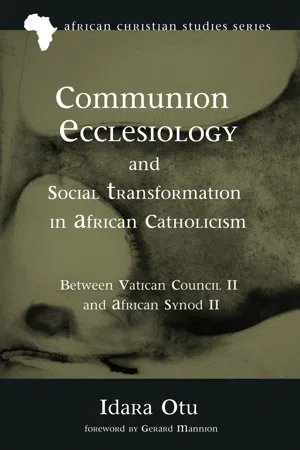![]()
Chapter 1
Vatican II: Communion Ecclesiology
and Social Mission
The Second Vatican Council was a beautiful work of the Holy Spirit, but after fifty years, have we done all that the Spirit asked us to do at the Council?
—Pope Francis
This chapter introduces the Second Vatican Council’s theological foundation for the church’s self-understanding as communion—a church sent by the triune God on a transformative mission to the world. For this reason, the chapter is lengthy as it kneads together the creative interplay and interconnection between ecclesial communion and social mission. The chapter reviews the biblical and patristic understanding of communio language, its appropriation among selected Roman Catholic ecclesiologies, and its intimations in the conciliar and post-conciliar documents. The chapter further explores the theological basis implicit in Gaudium et Spes in consonance with fulfilling the mission of social transformation. The chapter concludes with an exposition on the relationship between communion and mission.
Convened against the backdrop of anti-dogmatic movements, an essential focal point of the First Vatican Council (1869–70) was to define a systematic and comprehensive Catholic doctrine of the church. This conciliar agenda was only partially realized, due to the outbreak of the Franco-Prussian War (1870–71), which led to the suspension of the council. Nonetheless, Vatican I succeeded with the formal approval of Pastor Aeternus (PA), the “First Dogmatic Constitution on the Church of Christ.” This dogmatic text articulates certain fundamental teachings concerning the church: the institution of the apostolic primacy of Peter, the continuity and perpetuity of the primacy of Peter in the pope, the nature and power of papal primacy, and the definition of papal infallible teaching authority. Given this doctrinal exposition, Vatican I witnessed a theological validation of the visible aspects of ecclesial communion, with emphasis on ecclesial authority. According to Pastor Aeternus:
This contributed to the accentuation of a centralized vision and hierarchical dimension of the church, in the years leading to the convocation of the Second Vatican Council. However, between the suspension of the First Vatican Council and the eve of the Second Vatican Council, the theological discourse was characterized by ingenious spiritual models for the theology of the church. This set the stage for enlightened conversations and engaging debates at the Second Vatican Council concerning the theology of the church—ecclesia ad intra and ecclesia ad extra.
It is within this context that the Second Vatican Council is often described as an ecclesiological council in light of the context and content of the entire conciliar corpus. As Karl Rahner remarked, the Second Vatican Council “in all its sixteen constitutions, decrees, and declaration, was concerned with the Church.” A critical reading of the conciliar corpus shows that all the documents are interrelated, with theological summations relating to the nature and mission of the church. Two of the conciliar texts, Lumen Gentium and Gaudium et Spes, outstandingly focus on ecclesiology. These documents focus on the identity of the church ad intra and the mission of the church ad extra. This interpretation corresponds to the categories of communio (communion) and missio (mission) as essential paradigms of Vatican II ecclesiology of communion.
Biblical Foundations of Communion
The antecedents of the Catholic ecclesial self-understanding as communio emerged at the end of the twentieth century. Foremost is the adoption of the Reformation’s conception of communio as fellowship and the Orthodox notion of koinōnia in relation to both eucharistic and Trinitarian communion. Secondarily the Roman Catholic notion of communio, is grounded in patristic ressourcement and Roman Catholic eucharistic theologies. Each of these trajectories is distinguished conceptually, but interrelated and complementary in their application of the concept of koinōnia to express ecclesial communion.
The Greek koinōnia is commonly translated into Latin as communio and into English as communion or fellowship. The lexical root of koinōnia is the adjective koinos, which means “(in) common,” or “communal.” It denotes a sense of close participation and fellowship, pointing to a spiritual sharing in a common reality. The noun koinōnia is a derivative of the verb koinōneo, which can be translated as “to share,” or “to participate,” or “to fellowship.” This understanding of koinōnia expresses the sense of common participation and commonality, in contrast to the idea of what is private (idiom), which cannot be participated in, or held in common by every person. Though a mélange of cognate terms are derived from the etymological roots of koinōnia, the most pertinent Latin rendering is communio.
The philology of the Latin word communio has two roots: cum-moenus, which means “to have a common defense,” and cum-munus, which means “to...
